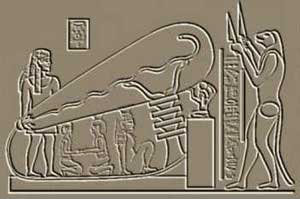|
The bottom of the cylinder was capped with a
crimped-in copper disk and sealed with bitumen or asphalt. Another
insulating layer of asphalt sealed the top and also held in place an
iron rod suspended into the center of the copper cylinder. The rod
showed evidence of having been corroded with acid. With a background
in mechanics, Dr. Konig
recognized this configuration was not a chance arrangement, but that
the clay pot was nothing less than an ancient electric battery.
When the vases were lightly tapped a blue patina
or film separated from the surfaces, characteristic of silver
electroplated to copper. It would appear then that the
Persians inherited their batteries from the earliest known
civilization in the Middle East. Return to Batteries and Electric Devices
In the scene, to the extreme right appears a box on top where sits an image of the Egyptian god Atum-Ra, which identifies the box as the energy source. Attached to the box is a braided cable which electromagnetics engineer Alfred D. Bielek identified as virtually an exact copy of engineering illustrations used today for representing a bundle of conducting electrical wires.
The cable runs from the box the full length of the floor of the picture, and terminates at both the ends and at the bases of the tube objects. These objects each rest on a pillar called a djed, which Bielek identified as a high-voltage insulator.
The tube objects look very much like TV picture tubes, an impression
which is not far from wrong, for electronics technician N.
Zecharius
has identified the objects as Crookes or electron tubes,
the forerunner of the modern television tube.
In several instances, both men and women are shown sitting underneath the tubes, hands held out and cupped, which meant they were in a receptive mode.
What kind of radiation treatment
was being performed here? Return to Batteries and Electric Devices
|
